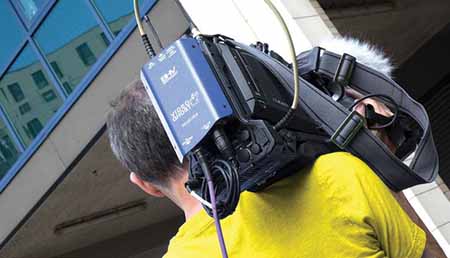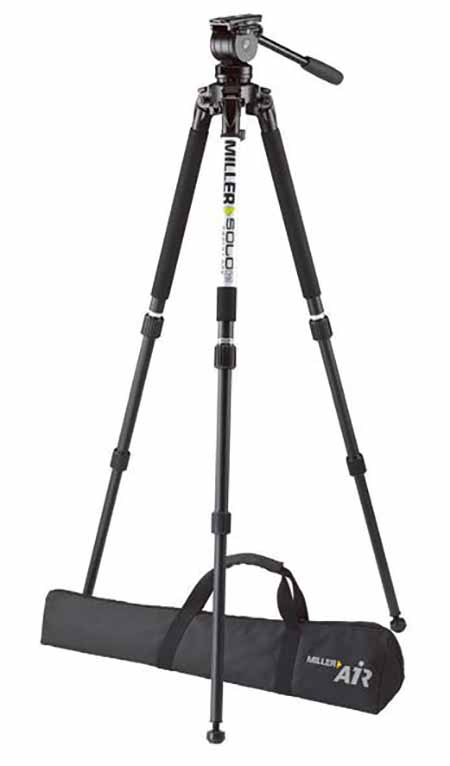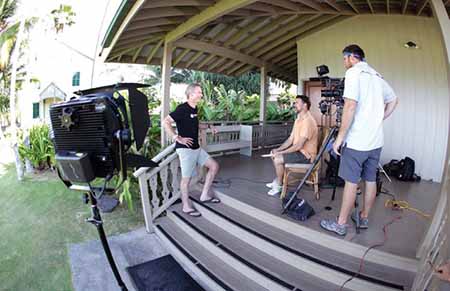New Gear for Today’s Well-Equipped VJ
SEATTLE

Anton/Bauer’s Digital Series Battery Packs
—The term “one-man-band” has been an apt description of small-market video journalists, required to work both in front of and behind the camera. Since they were expected to do it all with equipment more optimized for a two- or more-man crew, these VJs have longed for the day they’d graduate to the larger markets where they could specialize in one side or the other of the camera.
As the saying goes, there’s good news and bad news. The good news is that the big markets are looking for news folks with their skill sets, and are hiring. The bad news is that many of them are going to be expected to do the “one-man-band” thing again, now or shortly into the future.
There’s one more piece of good news, however: gear makers are paying attention to this trend, and are making field equipment that’s much more user-friendly to the solo VJ.
REPORTER-OPERATOR
Tom Jennings, president of Accelerated Media Technologies, an Auburn, Mass.-based provider of mobile broadcast vehicles, says they’re reacting to what these larger stations are doing.
They want the reporter to be able to be the complete operator of the vehicle,” Jennings said. “So we’ve designed small live trucks around the Nissan NV200s, their small miniature van, to be operated by reporters or the video journalists. They have a remotely operated camera on the roof, 17-inch flat screen monitor built into the side, with cellular bonding and KA-band satellite dish, with one-button deploying so the operator doesn’t really need to know anything technical.”
When something technical does need to be done, it can be accomplished via IP, according to Jennings. “There’s a complete IP transport stream, and you can control aspects of the truck remotely from the station, you can control LiveU and color settings, you can control the camera, you can control really any part of the truck remotely,” he said.
Get the TV Tech Newsletter
The professional video industry's #1 source for news, trends and product and tech information. Sign up below.
EXTENDING POWER

BHV Broadcast’s Video Ghost provides long video and DC power transport over simple and lightweight coax cable.
Whether you’re a one-man-band or a large news crew, power cables are a fact of life. If you’re talking about 10-15 feet, weight and cost are no big deal, but if you’re talking several hundred feet, how long it takes to deploy and retrieve a power cable is a big deal.
Slimming a power cable down to the size of a strand of coax was the object of BVH Broadcast’s Easy-DC product. “It provides low-cost, long-distance power for monitors, cameras and LED lights,” said Julian Hiorns, managing director of the U.K.-based company. “And we can deliver that power over a kilometer [3,000 feet], over inexpensive coax that’s easy to handle on a reel.”
Solo VJs can be hard on gear, according to Kieran Foster, vice president of product management at U.K.-based Vitec Videocom. “From the one-man-band perspective, they’re working fast and furious, and they’re probably not taking a lot of time to be ultra-careful,” he said.
With added safety in mind, Vitec’s Anton/Bauer brand recently introduced its Digital Series battery packs. “It gives them that piece of mind that if they drop the battery, or it gets bashed, there are crumple zones built into it,” Foster said. “The battery cellpack itself is isolated so it’s not going to take the impact the outer case will.” Digital Series batteries also provide approximately 1,000 recharge cycles, which would come to more than three years of service under heavy use.
LIGHT AND SIMPLE

Miller Air Tripod System
When it comes to camera support gear for the solo VJ, tripods need to be not only reliable, but simple to operate, according to John O’Keefe, vice president for U.S. Operations for U.K.-based Shotoku. “Our lightweight, compact SP60 handles everything from eight to 15 pounds, with very simple two-step pan-and-tilt drag control, two-step leg lock.” He noted that a mid-level spreader is preferred because the tripod is likely to spend a lot of time on uneven surfaces or straddling seats in auditoriums.
The VJs themselves might prefer carbon-fiber legs on the tripod because they weigh less than aluminum legs. But O’Keefe said the composite legs often get sacrificed for cost reasons.
Gus Harilaou, sales manager for Miller Camera Support, cautioned that in the pursuit of carrying less weight, a video journalist can sacrifice some important tripod performance. “At some point, a tripod can become too flimsy and will subject the camera to shaking and vibration in the slightest wind.”
Harilaou pointed to Miller’s Air Tripod System—which features more substantial construction than its lighter-weight counterparts— as a better bet. “The Air Tripod System is purpose-built for professionals who desire a compact, lighter and more agile camera support solution with the same unwavering durability that is standard of Miller tripods,” he said.
Tino Liberatore, product manager for K-Tek’s ProShot multifunctional camera support in Vista, Calif., touts the production value a VJ can bring to his work with a single six-pound tool that configures instantly into four different camera mounts. “You’ve got a hi-hat, a stabilizer, a mono-pod and you’ve got a shoulder mount,” he said. “If you see a shot that cries for a low angle, or a stabilized move and so forth, without tools and without dismounting the camera you can configure and reconfigure the ProShot in seconds.”
SOME LIGHT ON THE SUBJECT

Zylight’s F8 LED Fresnel
Portable lighting used to mean close to 20 pounds of battery and lamphead, with well less than an hour of illumination. Modern lighting technology has changed all of that, to the benefit of the solo VJ. Bad weather makes for big news stories, so lighting fixtures have to be able to take the rains. AAdynTech has made very heavy outdoor weatherproof lights but recently introduced the Hurricane Junior, a small, rugged, compact LED fixture that targets news crews, including VJs, according to John O’Keefe, in charge of global business development for the Paramus, N.J.-based company. “The Hurricane Junior is IP65, so it’s totally weatherproof, able to withstand rain, even hurricanes.” (IP65 refers to “ingress protection,” a rating that determines the enclosure of electrical equipment.)
The light draws less than an Amp, but puts out light equivalent to a 200-300W PAR HMI fixture. It’s daylight color-balanced, but comes with a filter for tungsten- balanced light as well as lenses that control the output and the dispersion of the light, O’Keefe added. Also included is a Chimera that allows the user to match the softness of a panel light. “It’s great for lighting interviews 6 to 12 feet away,” O’Keefe said.
Cineo has introduced the Matchbox, a lighting fixture about the size of a large box of kitchen matches, according to Rich Pierceall, co-founder of the El Granada, Calif.-based company. “It can be an on-camera light, but of equal importance is that it has enough output that it’s ideal for using in a three-point lighting setup,” he said. The Matchbox employs Cineo’s remote phosphor technology, where the phosphor that provides the color to its LED fixtures is not doped directly on the LED bulbs, but is applied to interchangeable translucent panels in front of the LEDs. “And you can use a remote dimmer in combination with the onboard dimmer on the Matchbox,” said Pierceall. “So for a quick and easy three point lighting setup, you can set the desired ratio of light between the fixtures, and then you can use the downstream dimmer that’s controlling all three of them to bring them up or down all together.”
Since solo VJs don’t carry a truck full of lighting equipment, it’s desirable to have a lighting kit that provides a lot of options, according to Ryan Smith, president of K5600 in North Hollywood, Calif. The company’s Evolution Kit targets these users, providing users with two lights, stands and all the accessories in one compact kit package.
“For somebody who’s in that one-man-band situation who could be indoors or outdoors, and on their own, they would have everything they need to light a setup, and then have some accessories to shape the light in a way to create some effects.”
Though the Evolution Kit can be ordered with two of the same light fixtures, Smith noted that for maximum flexibility a VJ might want to carry one of the K5600 Alphas, a traditional Fresnel instrument, and a Joker, a modified PAR instrument. “Changing color temperature in either fixture is done with a quick bulb swap.”
Scott Stueckle, sales manager for Kino Flo Lighting in Burbank, Calif., also suggests two different CFL light fixtures for a VJ’s lighting kit. “The first is the BarFly 200, where you want a key light or a fill source,” he said. “You can put it on a stand or hold it in your hand, even tape it on the wall because it’s lightweight. But it’s definitely a light you can grab and go with.”
For softer lighting, the company offers the Diva-Lite. “The fluorescent tube Diva provides light that’s soft, reliable, and it gives you that soft key and fill that’s essential when you’re trying to create that good picture,” Stueckle said. “Also these things take just a half an Amp of power.” For the BarFly and Diva fixtures, color temperature is changed by switching bulbs.
SMALL BUT POWERFUL
Sometimes field gear requires a tradeoff in performance. But Ali Ahmadi, senior product manager for Litepanels in Chatsworth, Calif., pointed to the company’s new Astra that’s built on the same form-factor as the company’s original 1x1 LED panel fixture, but puts out as much as four-times the light of the original 1x1. “You have tons of intensity that you can use, or you can just dim down, and then if all of the sudden you need a lot of light, you can run it back up,” he said.
Ahmadi adds that the variable intensity comes in handy for a morning news VJ doing an outdoor liveshot. “When he starts, it might be dark out and you would want to dim the Astra down so you could see the streetlights in the background,” he said. “But as the sun came up and it got lighter and lighter, you could raise the intensity to fill in shadows on the VJ. And since the Astra has variable color temperature, the color of the light could change along with the color of the sunrise.”
Videssence will debut its Vidnell lighting kit at the 2015 NAB Show, according to Gary Thomas, national sales manager for the El Monte, Calif.-based company. “It’s a three-fixture LED kit, available in either daylight or tungsten and powered by AC or battery,” he said. “The lights are designed around Fresnel lenses, and it’s going to be ideal for quick three-point lighting setups for interviews and standups.” The kit weighs less than 50 pounds, and occupies a soft-sided roll-around case. The lampheads draw less than one Amp each to give a long run-time when powered by batteries.
With stations putting their video journalists in smaller vehicles, compact lighting fixtures are a must, according to Charlie Collias, senior vice president for worldwide sales at Zylight in Los Angeles. “Our F8 has a small footprint, but it’s got a Fresnel lens that provides a lot of control of the light,” he said. “The F8 has a typical output of a 1,000W HMI fixture, which is usually a very large instrument. But the F8 is just 4.5 inches thick, and can be packed easily in the van.”
